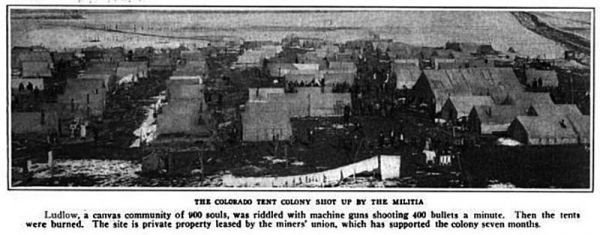Sunday was the 100th anniversary of the Ludlow Massacre in the coal mining
region of Colorado. In the fall of 1913, 11,000 miners went on strike,
protesting dangerous work conditions and low pay. Evicted from company
housing, they set up a tent city for months. The mining company,
CF&I, responded by patrolling with an armored car with a mounted
machine gun, shooting at the strikers occasionally. There was violence
on both sides, with company officials and strikebreakers also fired
upon. The National Guard was called in, to the relief of the strikers.
But instead of providing protection from violence, the Guard was used to
escort scabs into the mines and confiscate striker’s firearms. Matters
came to a head on April 20, 1914.
No one knows who
fired the first shot. Some soldiers would later testify that the
strikers’ bullets were already whizzing at them when an officer set off
the three explosive charges that had been prepared as a signal for
battle. Others would recall hearing the explosions before any shots.
Witnesses on both sides remember a lone figure, Louis Tikas, waving a
white handkerchief and running frantically back to the tents, trying to
head off disaster.
It was already too late. The militia opened
fire on the men in the railroad cut. Linderfelt arrived, and the machine
gun was installed on a slight rise overlooking the colony. As the day
wore on, shots issued from the tents, and the militia returned fire.
Officers would later testify that they’d seen women fleeing earlier and
didn’t know there were any noncombatants left in the colony, but it
seems hard to believe that the soldiers weren’t aware that the flimsy
tents contained scores of the defenseless and unarmed.
As troops
tried to close in on the shooters in the railroad cut, Private Alfred
Martin was shot in the neck — the first and only militia fatality of the
day. A passerby, trying to negotiate the road between the colony and
the militia, was killed instantly. Eleven-year-old Frank Snyder, who’d
left the protection of a cellar during a lull in the shooting, caught a
bullet in the head as he sat in his family’s tent.
That
night, the tent city burned, and two women and eleven children were
found dead of suffocation in a cellar. In response, the miners went on a
ten-day rampage, dynamiting mine facilities and shooting. Six strikers
and 24 mine employees were killed during this period before President
Wilson sent in federal troops. Somewhere
between 69 and 199 people were killed over the course of the strike.
Read an account of what happened at Ludlow at Westword.


No comments:
Post a Comment